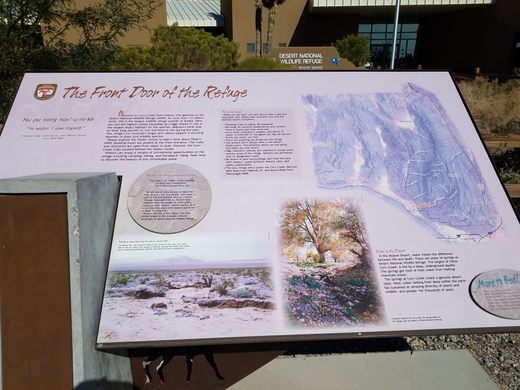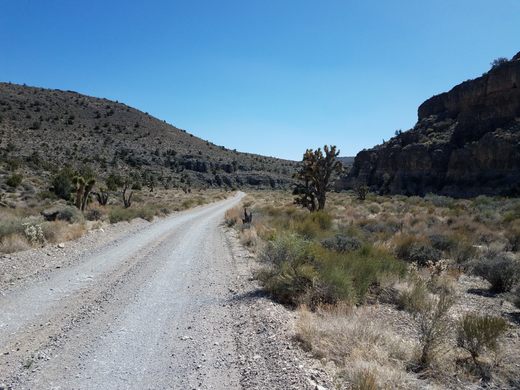Desert National Wildlife Refuge
Improbably, the largest wildlife refuge in the conterminous 48 states sits just northwest of Las Vegas, Nevada.
The Desert National Wildlife Refuge was originally established in 1936 specifically to preserve habitat for the desert bighorn sheep, although it is now managed for the benefit of all wildlife. It encompasses some 1.6 million acres, although about half overlaps with the Nevada Test and Training Range (NTTR) to the west, where the US Air Force carries out training missions. Formerly called the Nellis Bombing and Gunnery Range, this part has no routine public access.
The rugged Sheep Range extends some 40 miles north-south and dominates the publicly accessible part of the Refuge. It consists largely of limestone bedrock that weathers into spectacular cliffs and ragged spires. The range supports a ponderosa pine forest in the higher elevations, while at lower elevations there is extensive pinyon-juniper forest, and at even lower elevations extensive Joshua tree and yucca stands. A typical Mojave desert flora is present in the lowest elevations of the refuge
The refuge is mostly managed as wilderness with limited vehicle access. Only two primitive roads, the Alamo Road and the Mormon Well Road, cross the public part of the Refuge, and each has only a handful of spur roads. Off-road motorized travel is not permitted. However, backcountry travel on foot, including backpacking, is allowed.
The Refuge headquarters is at Corn Creek on the south side, where there is a visitor center with a large museum and even a gift shop. There are also several short trails to natural and historic sites, some of which are ADA accessible. These trails stress the historical importance of the springs at Corn Creek to wildlife, Native Americans, and early settlers in this extremely arid area.
Know Before You Go
The main access is through Corn Creek. It is not recommended to come in via the Alamo or Mormon Well roads on your first visit! To get to Corn Creek, take US-95 north 9.4 miles from the intersection with State Route 157 (the Kyle Canyon road). The turnoff is on the right and should be well marked. It is now 3.6 miles to the Visitor Center. Although the road is paved to the Visitor Center, the roads onto the Refuge beyond are very rough, with high clearance required at a minimum and in some cases also 4wd. A spare is a must, and be sure to fill up beforehand. Bringing plenty of water is also strongly recommended.
A primitive campground is located at Desert (Mormon) Pass, 28 miles from Corn Creek on the Mormon Well Road. It has 6 sites and vault toilets but no water, but there is also no fee. Car camping ("boondocking") along established roads in existing turnouts is also allowed with no fee.
Although there are only a few designated hiking trails, cross-country hiking and back-country camping are allowed without a permit. Dogs on lead are also OK. However, fires are not allowed in the backcountry, although backpacking stoves are permitted. Water is also extremely limited in the backcountry--there are very few springs, and no perennial streams--and adequate amounts must be brought. Also, any spring water must be treated.
Plan Your Trip
The Atlas Obscura Podcast is Back!



























































Follow us on Twitter to get the latest on the world's hidden wonders.
Like us on Facebook to get the latest on the world's hidden wonders.
Follow us on Twitter Like us on Facebook